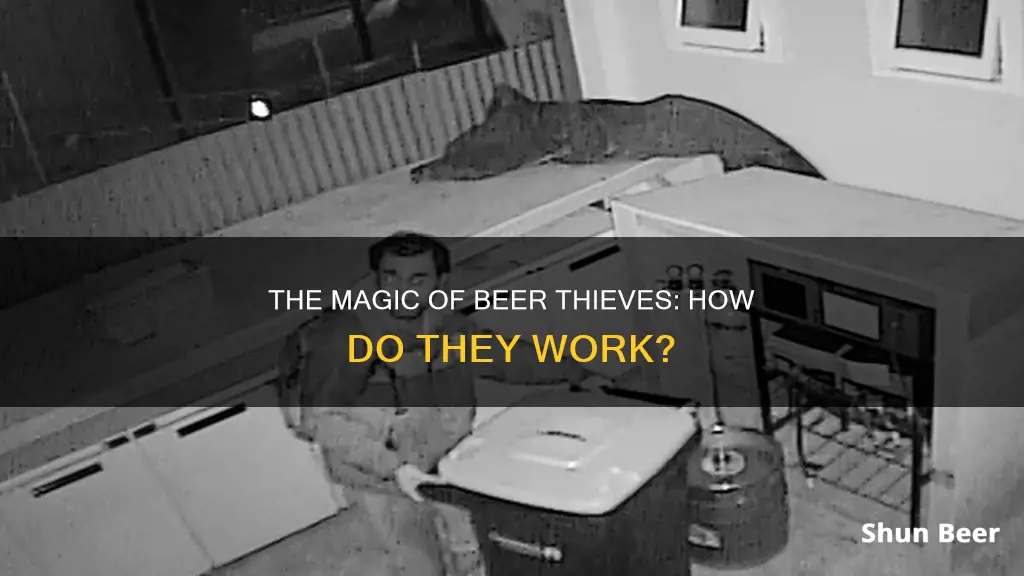
A beer thief is a tool used by brewers to draw small samples of beer from a fermentation vessel, such as a bucket or a carboy. It is a long, narrow tube with a chamber at one end for collecting the beer and a handle at the other. The beer thief is used to monitor the progress of the fermentation process, allowing brewers to check the beer's gravity, taste, aroma, and clarity. It is also used to collect samples for hydrometer readings, which help determine the alcohol content and the completion of fermentation.
What You'll Learn

Sanitation and contamination
Sanitation:
- Cleaning and sanitizing are distinct processes. Cleaning involves removing soils like dust, food particles, chemicals, and water scale from equipment surfaces, while sanitizing involves treating cleaned surfaces to kill microorganisms.
- Effective sanitation requires prior cleaning because soils can harbour microbes, shielding them from sanitizers.
- Sanitation prevents the carryover of unwanted flavours, chemicals, allergens, and particulates, ensuring the beer only contains intended ingredients.
- All brewery equipment, including fermentation vessels, hoses, and fittings, should adhere to a strict cleaning regimen to avoid off-flavours and infections.
- Environmental sanitation is crucial. A clean brewing environment, free from dried beer stains, mould, or debris, reduces the risk of contamination.
- Regular maintenance is essential. Stainless steel equipment should be inspected for issues like pitting or cracks, and rubber goods like gaskets and seals need periodic replacement as they degrade over time.
- When handling cleaning chemicals, always wear gloves and other protective gear.
- Common cleaning agents include Powdered Brewery Wash (PBW), caustic soda, and various acid-based and oxygen-releasing disinfectants.
Contamination:
- Contamination can result from physical, chemical, or biological sources, with biological contaminants being the most common.
- Physical contaminants are physical particulates like food residue, dust, or hardware entering the beer.
- Chemical contaminants refer to residual cleaning chemicals in the beer, often mitigated by thorough rinsing after cleaning.
- Biological contaminants are unintended microorganisms like Lactobacillus, Pediococcus, and wild yeast strains, which can cause off-flavours, reduced shelf life, and, in rare cases, foodborne illnesses.
- Contamination can become systemic and challenging to eradicate, so prevention through sanitation is vital.
- While alcohol in beer minimises the risk of pathogens, it doesn't eliminate it, and improper sanitation can still result in unpleasant flavours.
Beer Distributors: The Logistics of Getting Beer to Customers
You may want to see also

Sampling during fermentation
A beer thief is an indispensable tool in the brewing process, allowing brewers to monitor fermentation and make informed decisions to ensure the quality of their beer. One of its primary purposes is to take samples of beer during fermentation, providing insights into the progress of this stage.
Preparation:
Before using the beer thief, it is crucial to sanitise it thoroughly to prevent any contamination. Rinse it with a non-alcohol-based sanitiser and ensure it is completely dry before proceeding.
Drawing the Sample:
- Submerge the beer thief: Gently insert the beer thief into the fermentation vessel, which is usually a fermenting bucket or a carboy. Ensure that the vessel is sealed properly to maintain sanitation.
- Collect the sample: Once the beer thief is submerged, slowly draw out a small sample of the beer. The amount of beer collected will depend on the specific requirements for testing.
- Observe the sample: After withdrawing the beer thief from the vessel, carefully observe the sample. Check for any signs of unusual odour, taste, clarity, or appearance that might indicate potential issues during fermentation.
- Return the sample: If you intend to return the sample to the vessel, do so carefully to minimise the risk of contamination. Ensure that the vessel's opening is sanitised, and slowly pour the sample back.
Testing and Analysis:
- Hydrometer readings: One of the critical tests during fermentation is determining the alcohol content and assessing when fermentation is complete. Use a hydrometer to take readings from the sample. These readings will provide valuable information about the sugar content and fermentation progress.
- Sensory evaluations: Use your senses to evaluate the sample. Assess factors such as flavour, aroma, colour, and overall sensory characteristics. This will help in making any necessary adjustments to achieve the desired beer profile.
- Contamination detection: By carefully examining the sample, you can detect any signs of contamination early in the process. If you notice any off-flavours or unusual odours, take immediate corrective actions to address the issue and prevent further contamination.
- Record-keeping: It is essential to maintain detailed records of each batch. Document specific gravity readings, tasting notes, and any other observations made during sampling. These records will serve as a valuable reference for future brewing endeavours, helping you refine your techniques and recipes.
Best Practices and Precautions:
- Always sanitise: Ensure that all equipment, including the beer thief, vessels, and any utensils, are thoroughly sanitised before and after use. This will significantly reduce the risk of contamination.
- Minimise exposure: Limit the amount of time the fermentation vessel is open during sampling. The longer it remains open, the higher the risk of airborne contaminants entering and affecting the beer.
- Sample size: Draw only the amount of beer necessary for testing and analysis. Excessive sampling can lead to unnecessary waste and potential disruptions to the fermentation process.
- Consistent sampling: To accurately track the progress of fermentation, establish a consistent sampling schedule. This will help you identify any deviations or anomalies during the process.
- Safe sample disposal: If you choose not to return the sample to the vessel, dispose of it safely and responsibly. Do not pour it down the drain, as it may contain high levels of sugar that can be harmful to plumbing.
A Beginner's Guide to Joining a Beer Crawl
You may want to see also

Hydrometer readings
A beer thief is used to draw small samples of beer from a fermentation vessel, such as a fermenting bucket or a carboy. One of its primary purposes is to collect samples for hydrometer readings, which are used to calculate the alcohol content and determine when fermentation is complete.
A hydrometer is a device that measures the density of a liquid in comparison to water. It is usually calibrated to read at 20°C (68°F) and uses a scale called specific gravity or "gravity" for short. The more dissolved sugar there is in a beer or wine solution, the higher the hydrometer floats, resulting in a higher reading on its scale.
To obtain a hydrometer reading, you will need a trial jar, which is a specific jar used with the hydrometer. First, use a wine thief (pipette) or a beer thief to draw a sample of the beer into the trial jar. Half-fill the jar to avoid spillage, then fully submerge the hydrometer into the liquid. Wait for the hydrometer to settle, and give it a spin to eliminate any air bubbles. Take note of the reading at the centre/base of the curve in the liquid surface, known as the meniscus. This reading will enable you to calculate the alcohol content of your beer later in the process.
After taking the reading, you can either discard the sample in the trial jar or return it to the fermenter, as long as the equipment is properly sanitised to prevent contamination. Some beer thieves, such as the Fermtech Wine/Beer Thief, are designed to allow you to insert a standard hydrometer directly into the thief, eliminating the need for a separate trial jar.
Beer Caramelizer: How Does It Work and Why?
You may want to see also

Sensory evaluations and quality control tests
Understanding Sensory Evaluations
Sensory evaluation is a scientific method used to assess beer through our senses of sight, smell, taste, touch, and even hearing. It's a complex process that involves flexible methods to determine differences and changes between various beers. This evaluation is essential for maintaining constant quality and sensory properties, which is crucial in a competitive market where consumer loyalty is paramount.
In-depth Sensory Analysis
The sensory analysis of beer typically includes four aspects: appearance, aroma, flavor, and mouthfeel. Appearance evaluation covers the beer's color, clarity, and foam characteristics, such as thickness, retention, and lacing. Aroma evaluation is quite intricate due to the numerous ingredients that contribute to the overall fragrance. Common descriptors used include grain, bread crust, caramel, and even unusual notes like "sweaty horse blanket" for certain specialty beers.
Flavor evaluation combines taste and aroma, with bitterness being a key element perceived at the back of the tongue. Defects in flavor often manifest as wet cardboard, cat urine, mold, or rancidity. Mouthfeel relates to the texture, weight, and body of the beer, as well as sensations like warmth, astringency, or slickness, all influenced by carbonation levels.
Quality Control Tests
Quality control tests are conducted by breweries to make informed decisions and maintain rigorous standards. These tests can be used to assess new products, the impact of different ingredients or methods, and to understand a beer's shelf life and flavor evolution. They also help compare their products to competitors, ensuring they remain competitive in the market.
The Human Factor
An important consideration in sensory evaluations is the human factor. The physical and physiological state of the evaluator can influence the results. For instance, a runny nose or stress can impact the ability to taste accurately. Additionally, the evaluator's diet, mood, experience, personal preference, and the tasting environment can all play a role in how a beer is perceived.
Standardized Terminology
To ensure consistency and accuracy in sensory analysis, standardized terminology is crucial. The Flavor Wheel, developed by Morton Meilgaard, is a widely used tool that provides a range of beer descriptors, helping to establish a common vocabulary for beer evaluation.
Statistical Analysis
After conducting sensory tests, the data must be analyzed and interpreted. Statistical methods are employed to understand the significance of any differences between samples. These can include parametric tests, which assume a predefined distribution pattern, and non-parametric tests, which make no assumptions about data distribution.
In summary, sensory evaluations and quality control tests are vital components in the art of brewing. They ensure that the final beer meets or exceeds expectations in terms of flavor, aroma, appearance, and mouthfeel, ultimately contributing to consumer satisfaction and brand loyalty.
Energy and Alcohol: Do Beer and Red Bull Work?
You may want to see also

Recipe development
Sampling During Fermentation
The beer thief allows brewers to take small samples of beer during the fermentation process. This sampling helps monitor the progress and ensure the beer is developing as expected. By drawing samples at different stages, brewers can check the beer's gravity, taste, aroma, and clarity. This information is crucial for recipe development as it provides insights into how different ingredients and techniques impact the final product.
Hydrometer Readings
Hydrometers are used to calculate the alcohol content and determine when fermentation is complete. The beer thief facilitates the collection of samples required for these readings. By taking samples at various stages of fermentation, brewers can gather critical data about the beer's sugar content and fermentation progress. This information is invaluable for recipe development, as it helps understand the relationship between ingredients, time, and fermentation.
Sensory Evaluations and Quality Control
The beer thief is also used for sensory evaluations and quality control tests. Brewers can assess factors such as flavor, aroma, and color, making adjustments as needed to achieve the desired characteristics. This iterative process of sampling and adjusting recipes ensures the development of unique and exceptional brews.
Contamination Detection
Early contamination detection is crucial to prevent ruining a batch of beer. The beer thief helps brewers identify potential issues early on. By regularly taking samples and analyzing them for off-flavors or unusual odors, brewers can take prompt corrective actions. This not only helps salvage the current batch but also prevents contamination from spreading to future batches.
Record-Keeping
Record-keeping is an essential aspect of recipe development. The beer thief aids in documenting specific gravity readings, tasting notes, and other vital information about each batch. These records serve as a valuable resource for future brewing attempts, helping brewers refine their recipes and maintain consistency in their beer's quality.
Beer Sleeves: Do They Keep Drinks Cool?
You may want to see also
Frequently asked questions
A beer thief is used to draw small samples of beer from a fermentation vessel, such as a bucket or a carboy, during the brewing process. This allows brewers to monitor the progress of fermentation and conduct quality control tests.
To use a beer thief, sanitise it first and then submerge it in the beer. Hold it vertically and insert a hydrometer, twisting to dislodge bubbles. Gently touch the tip to the inside of the vessel to return the sample.
Beer thieves can be made of glass or plastic.
A beer thief allows brewers to take small samples of beer during the brewing process without wasting large amounts of beer. It also helps to minimise the risk of infection during sampling.







